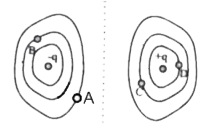During electron transport system (ETS) electron transport proceeds from carries that have ________redox potential to those having_____redox potential. This electront transport down the energy gradient leads to the formation of ATP from ADP and Pi, which is referred to as___________.
low, high, oxidative phosphorylation
low, high, oxidative decarboxylation
high, low, oxidative phosphorylation
high, low, oxidative decarboxylation
The correct Answer is:a
Many intermediate cytochromes and other carriers having their intermediate redox potentials are arranged in a series which transport electrons from NADH of FADH2 to O2. This sequence of electron carriers constitutes the electron transport system (ETS). The electron transport to those having high redox potential. The electron transport down the energy gradient through electron transport system leads to the formation of ATP from ADP and inorganic phosphate. This generation of ATP is called as oxidative phosphorylation.
Topper's Solved these Questions
Similar Questions
When the electrons pass from one carrier to another via complex-I to IV in the electron transport chain, they are coupled to ATP synthase (complex-V) for the production of ATP from ADP and inorganic phosphate.
View SolutionIn the electron transport system, a molecule of ATP is formed when an electron passes from :
View Solution
Knowledge Check
When a pair of electron from NADH(H+) is transported through respiratory ETS, it results in the formation of
A2 mol. Of ATPB4 mol. Of ATPC3 mol. Of ATPD5 mol. Of ATP.Assertion :- In cellular respiration, ETS electron movement is a downhill journey.
Reason :- Electrons move from high redox potential to low redox potential to low redox potential.AIf both Assertion and Reason are true and the Reason is the correct explanation of the Assertion.BIf both Assertion and Reason are true, but the Reason is not the correct explanation of the Assertion.CIf Assertion is false, but Reason is trueDIf both Assertion and Reason are false.The amount of energy required to remove an electron from the last orbit of an isolated (free) atom in gaseous state is known as ionization potential or first ionization potential of the element. Similarly, the energy required for the removal of the electron from the unipositive ion (produced above) is referred to as second ionization potential and thus the third, fourth etc. lonization potentials may be defined in general as the number of ionization potentials of an element may be as much as its number of electrons.
Ionization energy increases on moving down a group due toAincrease in the number of electronsBdecrease in size of elementsCscreening effectDnone of the above
The amount of energy required to remove an electron from the last orbit of an isolated (free) atom in gaseous state is known as ionization potential or first ionization potential of the element. Similarly, the energy required for the removal of the electron from the unipositive ion (produced above) is referred to as second ionization potential and thus the third, fourth etc. lonization potentials may be defined in general as the number of ionization potentials of an element may be as much as its number of electrons.
Ionization energy of nitrogen is more than that of oxygen which can be explained by
View SolutionThe amount of energy required to remove an electron from the last orbit of an isolated (free) atom in gaseous state is known as ionization potential or first ionization potential of the element. Similarly, the energy required for the removal of the electron from the unipositive ion (produced above) is referred to as second ionization potential and thus the third, fourth etc. lonization potentials may be defined in general as the number of ionization potentials of an element may be as much as its number of electrons.
Which of the following statemetn is correct ?
View SolutionThe process by which ATP is produced in the inner mambrane if a mitochondrion.The electron transport system transfer protons from the inner comartment of the outer,as the proton flow back to the inner compartment,the energy of their movements is used to add phosphate to ADP,forming ATP.
View SolutionFigure shows equi-potential surfaces for a two charges system. At which of the labelled points will an electron have the highest potential energy ?

View SolutionThe number of ATP molecules produced by electron transport system from Krebs cycle intermediates in a single trun is
View Solution